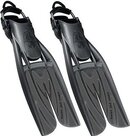- Messages
- 17,327
- Reaction score
- 13,749
- # of dives
- 100 - 199
Sure. Show me your skillz in staying comfortably buoyant in a bit of chop while wearing a wing with marginal lift. Ditching a few pounds (or kilos) will make life a lot easier for you in a situation like that and may mean the difference between "dead" and "alive".Sounds remarkably like an equipment solution to a skills problem.
I'm simply reporting the net effect of the current instruction. It routinely produces new divers that believe they need ditchable ballast for every configuration.
There are a lot of things you don't "need", but which makes life easier. If I'm adding lead to my rig, some of that will be ditchable. For two reasons: The aforementioned perk of being able to take it off and hand it to the boat tender to make it easier for me to climb aboard, and, more importantly, the option to increase my buoyancy from "just enough" to "ample" if I find myself on the surface and don't know when I'll be picked up. Or if I have to climb ashore on a cliff with a bit of waves around me. I prefer floating high rather than bobbing with my nose barely above the surface if I'm ever in a situation like that, and neither of those situations are extremely unlikely.
I agree that that's pretty stupid.I have had many ask, after I have explained that with little to no exposure suit that their regulator and bare bones BP&W is likely all the ballast they will need, if they should add a weight belt so they will have something to drop.
I also agree with you that that's silly.Start with a naked, fit diver and hand them a reg, full al 80 and a kydex plate and harness. They are now about -6lbs. Should they add a belt so they have something to drop?
We both know that's silly
OTOH, the risk of dying from not being able to ditch would be significantly bigger than the risk of dying from an accidental loss of weight. At least for a dive within NDL, and since we're in Basic I don't think deco diving is very relevant to the discussion. While shooting to the surface and dying from DCS is a well-known risk for tec divers, it's not a particularly common cause of death for rec divers. They are much more likely to die from making it to the surface and either drowning there or sinking back down. As a rec diver, I'd rather be bent than drowned.I think if you compared the frequency of having to ditch weights for safety vs accidental loss of weights due to quick due to pocket/belt failure, the latter would be more common.




